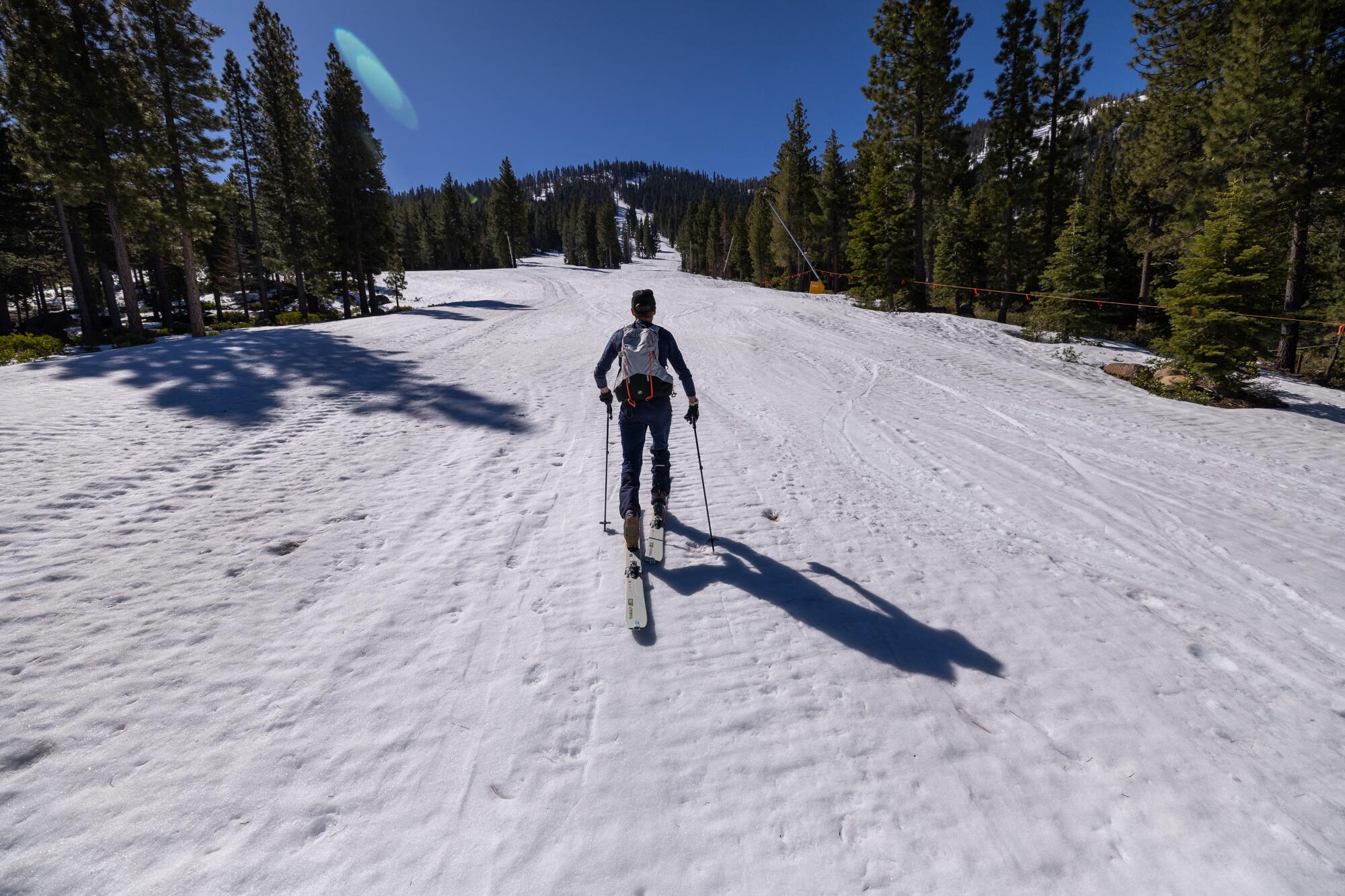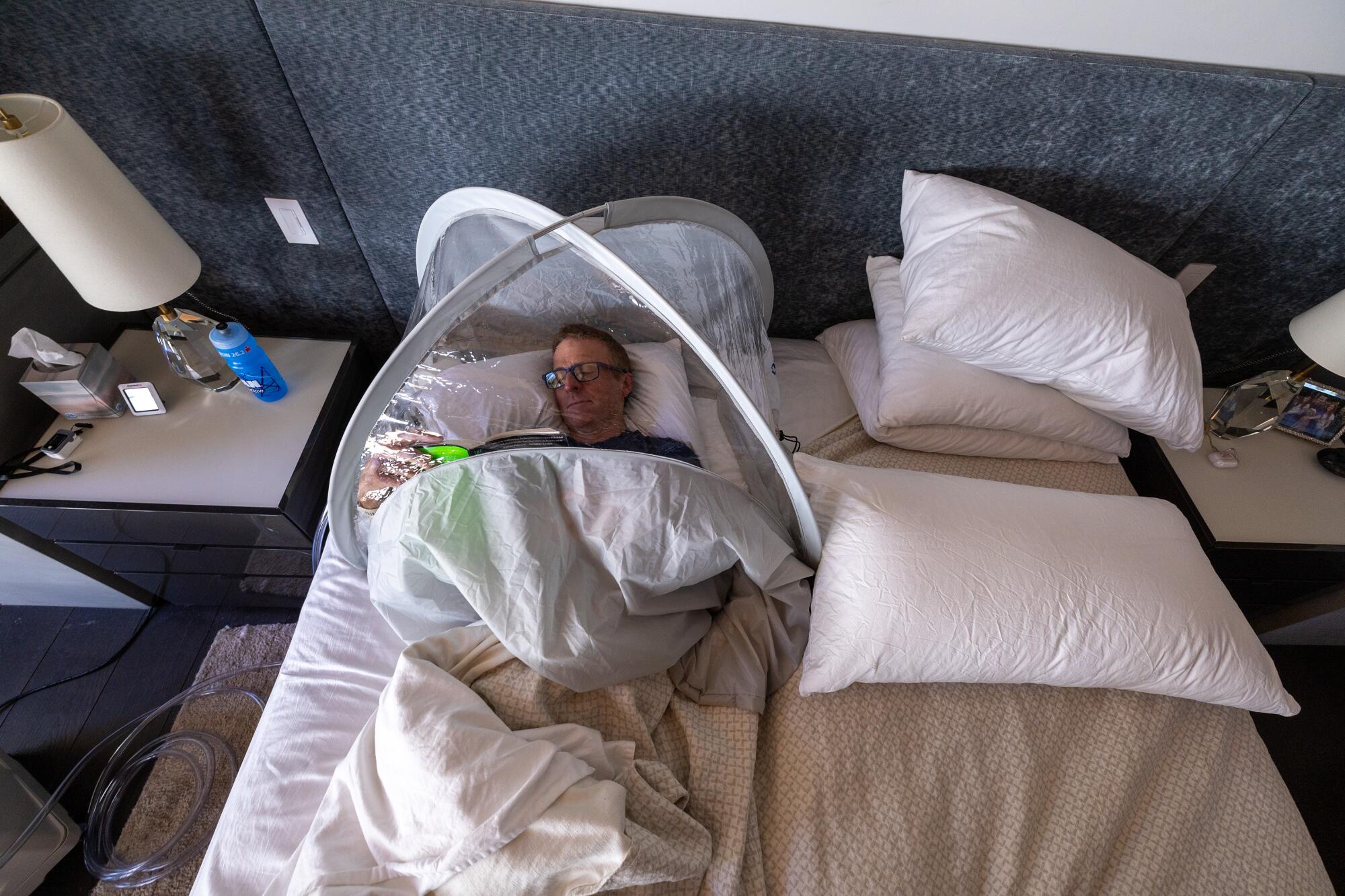Not just any bag. This one has a hose attached to a motor that slowly lowers the oxygen level to mimic, as faithfully as possible, the agonies of fitful sleep at extreme altitude: headaches, dry mouth, cerebral malaise.
“It’s not all bad,” Cooper insisted, nodding to the humming motor. “That’s like white noise.”
Cooper, 54, an Oakland biotech executive who has handled finance for a number of companies, including one that sold for $7 billion, isn’t a masochist, exactly. He’s acclimatizing, in the bedroom of his second home near Lake Tahoe, for an attempt to climb Mt. Everest in May.

He has signed up with an Olympic Valley-based guide service whose founder, Adrian Ballinger, is breaking with decades of tradition to create what he believes are better and more ethical ways to climb the world’s tallest mountain.
Ballinger said he was appalled by the risks, filth and ballooning crowds on the traditional southern trek up the mountain in Nepal. That’s the route familiar from countless documentaries and books, including the 1997 classic “Into Thin Air.”
So he decided to take clients up on the north side, a journey that starts in Tibet.
“It’s colder, the route is more difficult, and the bureaucracy of dealing with China and getting the permits is a complete nightmare,” Ballinger said. “But despite those things, the Chinese are attempting to regulate, so once you get on the mountain, it’s safer, it’s cleaner, and it’s much less busy.”
Ballinger is also pioneering a technique he calls “rapid ascent,” which cuts the duration of the expedition roughly in half: from about two months to about one. That suits his clients, who usually have more spare money than time. And it buys Ballinger more time to spend at home with his wife and newborn son.
The catch? You have to spend a few months before the trip with your head in the bag.
“It’s not great, I’m not gonna lie,” Ballinger said with a laugh, but the technology is improving.

Graham Cooper has been diligently training for his Mt. Everest climb, a regimen that includes skiing laps up and down the slopes near his Truckee home.
(Brian van der Brug / Los Angeles Times)
“Hypoxic tents,” as they’re called, have been used by other endurance athletes for years. In their original form, they would cover a client’s entire bed. That led to difficult conversations with spouses and partners about the necessity of sleeping at progressively higher simulated altitudes until they reached the height of Everest’s base camp, roughly 18,000 feet, where there’s about half the oxygen available at sea level.
As you can imagine, some clients wound up relegated to a couch with their bizarre-looking contraptions.
Cooper, who used one of the enormous old tents preparing for a 2015 trip to climb the highest peaks in Antarctica and South America, confessed he had no luck sweet-talking Hilary, his wife of 28 years, into sharing the adventure. He got bounced to a guest room.
“It was a lonely boy-in-the-bubble experience,” he said. But he has fond memories of the looks on his kids’ faces as they trooped into his little dungeon to kiss him good night.

Graham Cooper relaxes with a book inside an hypoxic tent that slowly lowers the oxygen level to mimic conditions at extreme altitude.
This time around, “the bag,” as he calls it, covers just his head and upper torso and takes up about a quarter of the bed. Hilary sleeps next to him, Cooper said, and she finds the hum of the motor surprisingly soothing.
It goes without saying that the luxury of acclimatizing at home, in bed, with your partner curled up beside you, represents a profound break from the usual manner of preparing to ascend what is still one of the world’s deadliest mountains.
The traditional method starts in Kathmandu, at nearly 5,000 feet, where climbers spend a few days getting over jet lag. That’s usually followed by a quick flight to the small mountain town of Lukla, at just over 9,300 feet. The airport there — perched on a narrow Himalayan shelf surrounded by towering peaks, with a steep drop-off at the end of the runway — is regarded as one of the trickiest places in the world to land an airplane.
From there, climbers begin a long, deliberately slow 10-ish-day hike to base camp. The point is to give the body time to gradually adjust to the lack of oxygen.

Mountain guide Adrian Ballinger says employing technology that allows clients to acclimatize to high elevations at home has allowed him to cut weeks off their expeditions to Mt. Everest.
Ballinger cuts nearly two weeks from his trips by driving his bedroom-acclimatized clients from the airport in Lhasa, Tibet, straight up to the northern route’s base camp, which is also at about 18,000 feet.
For some old-school purists, eliminating the long walk borders on sacrilege, said Will Cockrell, a journalist whose recent book, “Everest, Inc.,” explores the evolution of commercial guiding on the mountain. “They’ll say, ‘You’re not a real climber; you’re not a real nature lover,’” Cockrell said.
But since the arrival of big commercial expeditions on Everest in the mid-1990s — complete with Sherpas to install climbing ropes, chefs to cook meals in camp, team doctors to monitor health, and guides to accompany clients every step of the way — Mt. Everest has ceased to be a classic off-the-grid mountaineering challenge.
“It has come to represent something completely different,” Cockrell said, “something crazy to do to shake up your life, like running an Ironman.”
Ballinger makes no apologies. “We’re not old school, we don’t spend a lot of time sitting around drinking whiskey and playing cards,” he said.
That suits his clients, who “tend to be pretty type A, pretty high performing in everything they do,” Ballinger said.

Emily Turner, Alpenglow Expeditions’ Everest base camp manager, organizes supplies for a May trip.
They’d better be. His company, Alpenglow Expeditions, charges $165,000 (before tip) for a private climb, meaning one professionally certified guide per client, and $98,000 for a group climb with three clients per guide.
“We’re proudly expensive,” Ballinger said. “I’ve spent a lot of time thinking about what it takes to run a trip safely and ethically, and this is what it takes.”
Climbing from the north side, as Ballinger does, avoids the huge crowds who flock to the southern base camp from all over the world every May, the prime climbing season on Everest, to wait for a brief window of good weather to try to make it to the summit.
Anyone who has even loosely followed events on Mt. Everest in recent years is probably familiar with the terrifying “conga line” photos of climbers stuck in the world’s highest traffic jam.
It forms just below the summit on the southern route, at the last technical obstacle, a nearly vertical 40-foot rock wall called the Hillary Step. It’s on a ridge with a 10,000-foot drop to the climber’s right and an 8,000-foot drop to the left. So, when exhausted and inexperienced climbers inevitably struggle there, everybody else waits in a single file, hanging onto a fixed rope, while the bottled oxygen they need to survive at that altitude slowly drains away.

Graham Cooper is no stranger to grueling physical challenges. He has competed in the Ironman World Championship 11 times and has won the 100-mile Western States Endurance Run.
Worse is the Khumbu Icefall, a glacier just above the southern base camp. It’s best known for wide spine-tingling crevasses spanned by flimsy-looking aluminum ladders lashed together with rope. Climbers have to walk across those ladders, wearing big boots and crampons, as they make multiple trips back and forth to advanced camps to acclimatize before finally heading for the summit.
As dangerous as it is for the mostly foreign climbers and guides, the odds are even worse for the local Sherpas, who regularly traverse the Khumbu ferrying equipment — tents, food, oxygen canisters — for the climbing teams. Last year, the deadliest climbing season in Everest history, three Sherpas were killed in the Khumbu when a towering block of ice collapsed and buried them.
In six seasons climbing the southern route, from 2009 to 2014, Ballinger said he passed through the Khumbu 38 times and had two close calls. While nobody on his teams lost their lives there, he helped recover the bodies of other climbers who had not been so lucky.
Finally, he did the math and concluded there was no way he could get through a whole career — 20 or 30 years — without losing someone he was responsible for in the Khumbu.
“I just couldn’t do it anymore,” Ballinger said. “I just couldn’t justify the risk.”

Graham Cooper loads skis into his SUV, preparing for a back-country exercise session with his loyal dog, Busy.
Ballinger’s data-driven approach and stellar track record were enough to win over Cooper.
And he has been willing to wait.
He was ready to climb Everest four years ago, but when China shut down expeditions to its side of the mountain in 2020 in response to the COVID-19 pandemic, Ballinger stuck to his principles and refused to resume climbing with the crowds in Nepal. This is the first year since the pandemic that the Chinese side has been open.
The Alpenglow team, which includes 26 clients, guides and Sherpas hoping to reach the summit, were originally scheduled to begin their expedition in late April. After a late permitting change from the Chinese government, that date has been pushed back to May 7.
Cooper has competed in the Ironman World Championship in Hawaii 11 times and has won the legendary Western States Endurance Run, a 100-mile ultra-marathon. He is not a man accustomed to sitting around. “I’m feeling ready and anxious to get going,” he texted a reporter last week.
When not trying to sleep in his hypoxic tent, Cooper has spent his training days in Tahoe on back-country skis doing laps up and down a mountain, his 3-year-old dog, a Vizsla named “Busy,” at his heels. Indoors, he straps on a hypoxic mask hooked to the same motor he uses for the sleeping tent and rides a stationary bike an hour at a time. Or climbs a StairMaster. Or throws on his mountaineering boots and a heavy backpack and trudges up and down slopes.
Why?
“I’m addicted to doing this kind of stuff,” said Cooper, who ran his first marathon when he was 13. “I just feel like a fundamentally happier person when I’m training.”
Ballinger leads clients on bucket list climbs all around the globe. Many of the treks present more interesting technical challenges than Everest. Almost all of them feel like wild outposts compared with the circus vibe on Everest’s south side.
Still, he gets poetic when he describes why so many clients are drawn to the world’s tallest summit.
“Because it’s so hard,” he said. It takes incredible fitness, mental fortitude and a heavy dose of luck to make it to the top. And no matter how many precautions you take, there’s that uncontrollable element of risk.
“It’s not just a battle for success, it’s a battle for survival up there,” Ballinger said. “That’s something that many of us have not experienced otherwise. I think that really captures people.”
